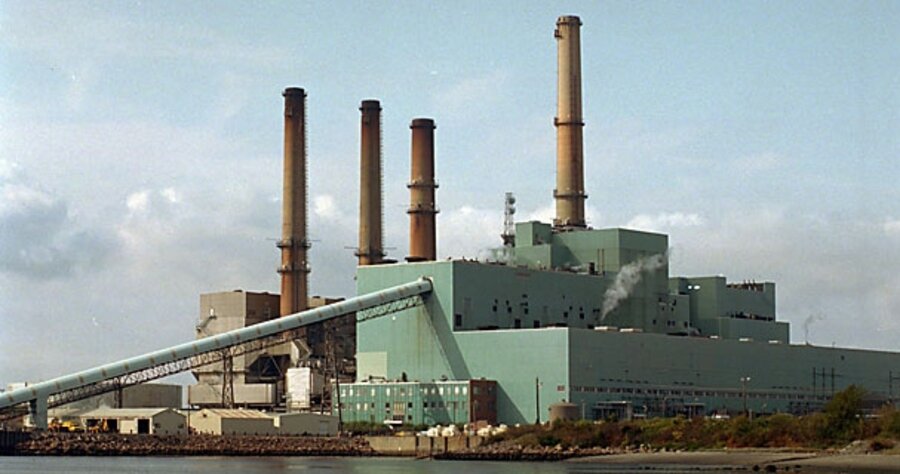Precedent-setting carbon auction Thursday
Loading...
For almost as long as people have worried about global warming, economists have called for taxing carbon emissions. As long as sending CO2 skyward was cost-free, they argued, the practice would continue.
Starting Sept. 25, for the first time in US history, a price tag will begin to be placed on millions of tons of carbon dioxide spewing from every major power plant from Maine to Maryland.
Just what that price will be won’t be known until after Thursday’s computerized auction of about 12.5 million tons of “carbon allowances,” essentially permission slips to pollute.
Utility companies will bid on the allowances. They may be used, saved, or traded so that any company with a need to send more CO2 up the stack can buy more – at the market price. The amount of CO2 to be cut over the next decade is modest – about 18 million tons annually (US power plants collectively emit about 2.8 billion tons of CO2 yearly). But the auction and process of setting a price for carbon are critical first steps, many say.
At least 15 other states in two groups – a Western and a Midwestern greenhouse-gas-reduction compact – are moving ahead with greenhouse-gas (GHG) reduction plans of their own. Congress, meanwhile, is mulling more than a half-dozen plans to cut GHGs nationwide.
So the 10 Northeast and mid-Atlantic states that make up the Regional Greenhouse Gas Initiative (RGGI) are guaranteed to get a lot of attention.
“It’s the first CO2 auction and first compliance market for carbon in the US,” says Emilie Mazzacurati, a senior analyst for Point Carbon, a carbon-market information company. “The RGGI states have really been pioneers. Now everyone is watching. But they’ve been really careful with their approach [to the auction] and I think they will get it right.”
Unlike a standard regulatory approach that simply limits emissions, the new “cap and trade” RGGI system adopted by Maryland, Delaware, New Jersey, New York, and the six New England states (Maine, New Hampshire, Vermont, Massachusetts, Connecticut, Rhode Island) is a market-based approach.
RGGI mandates that regional power plant emissions not exceed 188 million tons of CO2 annually for six years. After that, the cap drops 2.5 percent per year. By 2018, power plant emissions – and the cap – will have dropped 10 percent. Unlike previous cap-and-trade attempts, RGGI will auction nearly all its allowances instead of giving them free of charge to industry or “grandfathering” them.
When Europe’s carbon-trading scheme began in the early part of the decade, carbon permits were given to power companies to compensate them for the cost of cutting emissions. But power companies were also allowed to pass along the higher costs to consumers. The CO2 allowances, when sold on the carbon market, were a multibillion-dollar windfall.
“If power companies are given allowance for free, and they’re able to pass on their costs to ratepayers, they’re able to have a net profit from that policy,” says Richard Newell, a Duke University economist. “Auctions provide a mechanism for government to capture that potential windfall.” Those policymakers and economists who believe carbon regulation is inevitable say auctioning most allowances may be the fairest way to proceed.
Even some utility companies concur.
“We feel this [auction] is an appropriate step ... and we don’t believe it will be overly costly,” says Robert Teetz, environmental management director at National Grid, which expects to compete in RGGI auctions. Spurring “additional energy conservation is the right thing to do, and customers’ bills will go down.”
In RGGI’s case, most proceeds will go to fund energy efficiency programs to cut future energy demand.
Proceeds under a national plan could be huge – $100 billion or more. Besides funding energy efficiency and renewable energy, a substantial portion could be funneled back to low- and-middle-income taxpayers as tax breaks to compensate those most affected by rising energy costs, according to the Congressional Budget Office.
RGGI costs will be modest at the start. Already, futures contracts are being sold on RGGI allowances, putting their costs just under $5 per ton of CO2. But analysts like Ms. Mazacurrati see them dropping lower in price due in part to a shift by power producers away from oil to natural gas, which has lower emissions.
But that won’t necessarily last, and experts don’t think it will unduly dampen demand for the allowances.
“RGGI can’t solve the world’s carbon problem on its own,” says William Shobe, an economist at the University of Virginia who helped design the RGGI auction. It’s doing what it can – and it’s offering to be part of a national program.”
[Editor's note: The headline to the original version gave the wrong day for the carbon auction.]





